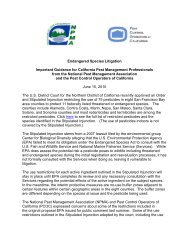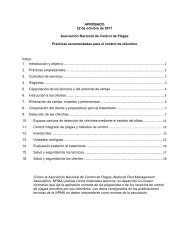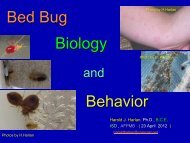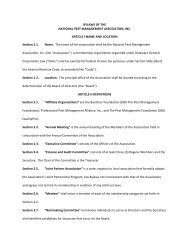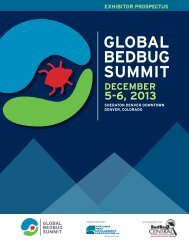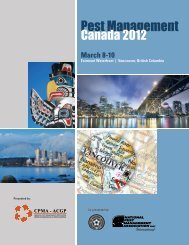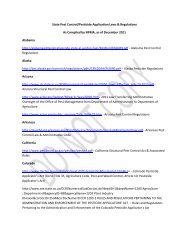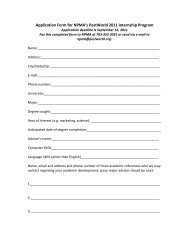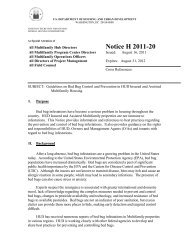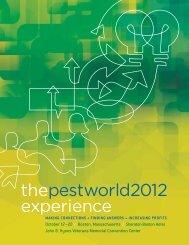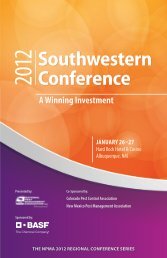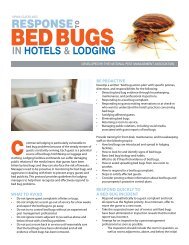Pest Management Standards For Food Plants - National Pest ...
Pest Management Standards For Food Plants - National Pest ...
Pest Management Standards For Food Plants - National Pest ...
Create successful ePaper yourself
Turn your PDF publications into a flip-book with our unique Google optimized e-Paper software.
SECTION 2: PEST MANAGEMENT PLAN<br />
2.8 Birds and Wildlife<br />
Birds and wildlife can enter plants or plant areas and create contamination or potential<br />
contamination hazards.<br />
2<br />
SECTION<br />
In the course of the inspection, maintenance issues such as but not limited to holes<br />
in walls, pipe chases, bulk feed lines, spilled food items, or open doors/windows shall<br />
be noted. Recommendations shall be made to the plant to reduce chances of future<br />
infestation.<br />
Bird Prevention/<strong>Management</strong><br />
Areas susceptible to infestation by birds shall be called to the attention of the plant<br />
contact. If the plant approves, bird prevention measures may be installed. These shall be<br />
any type of wire, net, device, or material to prevent roosting.<br />
No restricted use pesticides designed for scaring of birds may be used inside any structure<br />
where food is exposed. Any such product use shall be in areas inaccessible to non-target<br />
species and plant personnel.<br />
Any interior bird removal shall be by trapping and removal in accordance with<br />
regulations. Exterior infestations such as geese on grounds may be managed by scaring<br />
devices or repellents. Use must be in accordance with manufacturer’s instructions. Use of<br />
protective gear shall be required for removal of nests and/or droppings<br />
<strong>Plants</strong> should be encouraged to eliminate favorable conditions for bird infestation and<br />
observations by the technician shall be recorded in the log.<br />
Within the confines of the above, additional information on bird management may be<br />
found in the NPMA <strong>Pest</strong> <strong>Management</strong> Library, available through the NPMA Resource<br />
Center (www.npmapestworld.org).<br />
Wildlife Prevention/<strong>Management</strong><br />
Areas susceptible to infestation by wildlife shall be called to the attention of the plant<br />
contact. If the plant approves, wildlife prevention measures may be installed. These shall<br />
be any type of wire, net, device, or material to prevent entry, nesting, and/or roosting.<br />
This is usually beyond the scope of the original contract and a separate contract should be<br />
developed.<br />
Any miscellaneous animal removal shall be by trapping and removal in accordance<br />
with local regulations. Exterior infestations such as prairie dogs on grounds may be<br />
managed by repellents or other method according to label or instructions. Use must be in<br />
accordance with manufacturer’s instructions.<br />
<strong>Plants</strong> should be encouraged to eliminate favorable conditions for wildlife infestation and<br />
observations by the technician shall be recorded in the log.<br />
Within the confines of the above, additional information on wildlife biology and<br />
management may be found in the NPMA <strong>Pest</strong> <strong>Management</strong> Library.<br />
2.9 Weed <strong>Management</strong><br />
Vegetation should not be planted against the buildings (exterior). An inspection band and<br />
clear zone adjacent to the building should be encouraged as part of the periodic audit. If<br />
the company performs weed management, ideally a vegetation free clear zone should be<br />
maintained.<br />
This item shall be checked as part of the normal audit process during pest management<br />
service regardless of whether the company performs weed management. Any<br />
14



